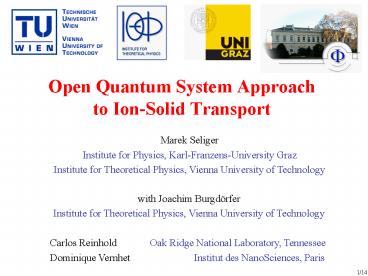Open Quantum System Approach to IonSolid Transport
1 / 16
Title:
Open Quantum System Approach to IonSolid Transport
Description:
Institute for Theoretical Physics, Vienna University of Technology ... 200 atto seconds - 20 femto seconds [1] D. Vernhet et.al., J. Phys. B 31, 177 (1998) ... –
Number of Views:50
Avg rating:3.0/5.0
Title: Open Quantum System Approach to IonSolid Transport
1
Open Quantum System Approachto Ion-Solid
Transport
Marek Seliger Institute for Physics,
Karl-Franzens-University Graz Institute for
Theoretical Physics, Vienna University of
Technology
with Joachim Burgdörfer Institute for Theoretical
Physics, Vienna University of Technology Carlos
Reinhold Oak Ridge National
Laboratory, Tennessee Dominique Vernhet
Institut des NanoSciences, Paris
2
What is an Open Quantum System?
interaction
open quantum system
environment
- exchange of
- energy
- probability
3
Outline
- Motivation
- Method
- Lindblad master equation
- quantum trajectory Monte Carlo method
- source and sink
- Application to ion-solid transport
- Outlook
4
Motivation
environment
interaction
open quantum system
- examples
- phonons
- plasmons
- electromagnetic field
- rest gas
- particle beams
- properties
- many degrees of freedom
- not influenced by system
- examples
- electron attached to ion
- quantum dot
- photons in cavities
- property
- strongly perturbed
goal describe dynamics within system
5
Open Quantum System ApproachWhere does the
Lindblad master equation come from?
Dynamics
- Born-Markov approximation
- s(t) TrErtotal(t)
- linear response, rE(t) rE(0)
- loss of memory
- Lindblad approximation
Liouville equation
Lindblad equation
HS .. system Hamiltonian L .. Lindblad
transition operators
solution wave function Monte Carlo techniques
(Mölmer, Zoller, Gardiner, Dalibard, et al.
1990s)
6
Monte Carlo Classical - Quantum
q
phase space
Hilbert space
discretization test particle (p,q)
wave function
stochastic trajectories
p
classical trajectory Monte Carlo Boltzmann
equation solved through Langevin equation for
Brownian particles
quantum trajectory Monte Carlo Lindblad
equation solved by non-linear stochastic
Schrödinger equation for wave functions
7
Quantum Trajectory Monte Carlo Method
state index
state index
N trajectories
1st trajectory
1st trajectory
state index
state index
N trajectories
time
non-linear stochastic Schrödinger equation
8
Open Quantum System Approachto Ion-Solid
Transport
exchange of probability
exchange of energy
environment (solid)
radiative decay
scattering
ionization
open quantum system (projectile)
1 e-
2 e-
0 e-
with atomic cores and electron gas
1st capture
2nd capture
9
Experimental Observation
carbon foil
Kr35 v47 a.u.
excitation ionization
electron capture
Ar18 v23 a.u.
photon detector 1
time scales of interaction 200 atto seconds -
20 femto seconds
1 D. Vernhet et.al., J. Phys. B 31, 177 (1998)
10
Experimental setup
spectrometer
targets
beam
spectrometer
high-resolution X-ray detector
D. Vernhet et.al., J. Phys. B 31, 177 (1998)
11
Application to Kr35 transportdensity matrix of
excited states
Kr35? C, v47 a.u.
12
Application to Kr35 transport
Kr35? C, v47 a.u.
1
1
35
ionization
36
1 D. Vernhet et.al., J. Phys. B 31, 177 (1998)
13
Application to Ar18 transport
Ar18? C, v23 a.u.
14
- Summary
- standard open quantum system approach
- generalization to include sink and coherent
source - solution by means of a quantum trajectory Monte
Carlo method - application to transport
- build-up of transient coherences
- decoherence in transport
- interplay of collisions, radiative decay and
coherent source - overall good agreement with experiment shows
applicability of the method
15
Outlook
- resonant coherent excitation
channeling path no direct collisions
I
periodic potential -gt laser field
I
I
resonant driving of coherence
- coherent wave packet dynamics in collisions
study decoherence due to collisions in a double
slit scheme
- quantum dot interacting with cavity probed by
laser - in the group of Karl Unterrainer (TU Wien)
cavity
quantum dot
laser
J. Reithmeier, et al., Nature 432, 197 (2004).
16
- Acknowledgements
Carlos Reinhold Oak Ridge National Laboratory
Joachim Burgdörfer Vienna University of Technology
Dominique Vernhet Institut des NanoSciences, Paris
Colleagues Yasmin Dollak and Axel Struß (Vienna
University of Technology)
Funded by Austrian Science Fund (FWF) EU-HITRAP
Project ADLIS Special research project































